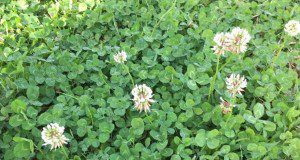Resumen
Weeds are a major contributor to yield loss and reduction in yield quality in an agricultural setting, competing with the crop for resources like light, water, and nutrients. This competition along with the cost of weed management strategies like tillage and herbicides, are responsible for the economic impact of weeds, which can reach into the billions. In addition to the damage caused by direct competition, weeds can also harm crop plants by acting as reservoirs for destructive plant pathogens, the insect vectors that move these pathogens from plant to plant, or both. The objective of this publication is to summarize previously published weed-pathogen associations to help growers scout and monitor pathogens in weeds near production areas.
https://edis.ifas.ufl.edu/hs1335
Citas
Adkins, S., S. E. Webb, C. A. Baker, and C. S. Kousik. 2008. Squash vein yellowing virus detection using nested polymerase chain reaction demonstrates that the cucurbit weed Momordica charantia is a reservoir host. Plant Disease 92: 1119-1123. https://doi.org/10.1094/PDIS-92-7-1119
Aftab, M., and A. Freeman. 2013. Temperate pulse viruses: Beet western yellows virus (BWYV). Agriculture Victoria, Note AG1419. http://agriculture.vic.gov.au/agriculture/pests-diseases-and-weeds/plant-diseases/grains-pulses-and-cereals/temperate-pulse-viruses-beet-western-yellows-virus-bwyv (Accessed 10 September 2018).
Alemu, T., J. Hamacher, and H. W. Dehne. 2002. The role of some weeds as hosts of Capsicum viruses in the rift valley parts of Ethiopia. Meded Rijksuniv Gent Fak Landbouwkd Toegep Biologische Wetenschappen 67: 283-289.
Baker, C., S. Webb, and S. Adkins. 2008. Squash vein yellowing virus, causal agent of watermelon vine decline in Florida. Plant Pathology Circular No. 407. Florida Department of Agriculture and Consumer Services Division of Plant Industry. https://www.freshfromflorida.com/content/download/11413/144774/pp407.pdf (Accessed 10 September 2018).
Dille, J. A., P. H. Sikkema, W. J. Everman, V. M. Davis, and I. C. Burke. 2016a. Perspectives on corn yield losses due to weeds in North America. Weed Science Society of America. http://wssa.net/wp-content/uploads/WSSA-2015-Corn-Yield-Loss-poster-updated-calc.pdf (Accessed 10 September 2018).
Dille, J. A., P. H. Sikkema, W. J. Everman, V. M. Davis, and I. C. Burke. 2016b. Perspectives on soybean yield losses due to weeds in North America. Weed Science Society of America. Abstract available: https://www.cambridge.org/core/journals/weed-technology/article/div-classtitleperspectives-on-potential-soybean-yield-losses-from-weeds-in-north-americadiv/839B31C6771865071E6956BAEFC0F076 (Accessed 10 September 2018).
Dikova, B. 2006. Establishment of Tobacco rattle virus (TRV) in weeds and Cuscuta. Biotechnology and Biotechnological Equipment 20: 42-48. https://doi.org/10.1080/13102818.2006.10817379
El-Wakil, M. A., G. E. Holcomb, and T. Harger. 1985. Occurrence and identification of some weed diseases and their consideration for biological weed control. Proceedings of the VI International Symposium on Biological Control of Weeds pp. 613-616. https://www.ibiocontrol.org/proceedings/volume.cfm?id=VI (Accessed 10 September 2018).
Gatton, H. A. 2015. Crop profile for sweet corn in Virginia. IPM Crop Profiles, Virginia Polytechnic Institute & State University. https://ipmdata.ipmcenters.org/documents/cropprofiles/VA_CP_SweetCorn_2015.pdf (Accessed 10 September 2018).
Goyal, G., K. G. Harsimran, and R. McSorley. 2012. Common weed hosts of insect-transmitted viruses of Florida vegetable crops. ENY-863. Gainesville: University of Florida Institute of Food and Agricultural Sciences. http://edis.ifas.ufl.edu/in931 (Accessed 10 September 2018).
Koenig, R., and D-E. Lesemann. 1989. Potato virus X. Description of Plant Viruses DPV 354, Association of Applied Biologists. http://www.dpvweb.net/dpv/showdpv.php?dpvno=354 (Accessed 10 September 2018).
Kucharek, T., and D. Purcifull. 2001. Aphid-transmitted viruses of cucurbits in Florida. Plant Pathology Department Circular 1184.
Papaix, J., J. J. Burdon, K. Zhan, and P. H. Thral. 2015. Crop pathogen emergence and evolution in agro-ecological landscapes. Evolutionary Applications 8: 385-402. https://doi.org/10.1111/eva.12251
Rupe, J., and L. Sconyers. 2008. Soybean rust. The Plant Health Instructor. DOI: 10.1094/PHI-I-2008-0401-01. https://www.apsnet.org/edcenter/intropp/lessons/fungi/Basidiomycetes/Pages/SoybeanRust.aspx (Accessed 10 September 2018). https://doi.org/10.1094/PHI-I-2008-0401-01
Shrestha, D., H. J. McAuslane, S. T. Adkins, H. A. Smith, N. Dufault, and S. E. Webb. 2016. Transmission of Squash vein yellowing virus to and from cucurbit weeds and effects on sweetpotato whitefly (Hemiptera: Aleyrodidae) behavior. Environmental Entomology 45: 967-973. https://doi.org/10.1093/ee/nvw086
White, N. H. 1970. Weeds as reservoirs of plant diseases. Council of Australasian Weed Societies, Inc. http://caws.org.au/awc/1970/awc197011821.pdf (Accessed 10 September 2018).
Wisler, G. C., and R. F. Norris. 2005. Interactions between weeds and cultivated plants as related to management of plant pathogens. Weed Science 53: 914-917. https://doi.org/10.1614/WS-04-051R.1
Yandoc-Ables, C. B., E. N. Rosskopf, and R. Charudattan. 2006. Plant pathogens at work: Progress and possibilities for weed biocontrol, Part 1: Classical vs. bioherbicidal approach. American Phytopathological Society Features. http://www.apsnet.org/publications/apsnetfeatures/Pages/WeedBiocontrolPart1.aspx (Accessed 10 September 2018). https://doi.org/10.1094/APSnetFeature-2006-0806
Zitter, T. A., and R. Provvidenti. 1984. Virus diseases of leafy vegetables and celery. Cornell University Vegetable MD Online, Fact Sheet Page 737.00.
Zitter, T. A., and J. F. Murphy. 2009. Cucumber mosaic virus. The Plant Health Instructor. DOI: 10.1094/PHI-I-2009-0518-01 https://www.apsnet.org/edcenter/intropp/lessons/viruses/Pages/Cucumbermosaic.aspx (Accessed 10 September 2018). https://doi.org/10.1094/PHI-I-2009-0518-01
Unless otherwise specified, articles published in the EDIS journal after January 1, 2024 are licensed under a Creative Commons Attribution-NonCommercial-NoDerivs 4.0 International (CC BY-NC-ND 4.0) license.

